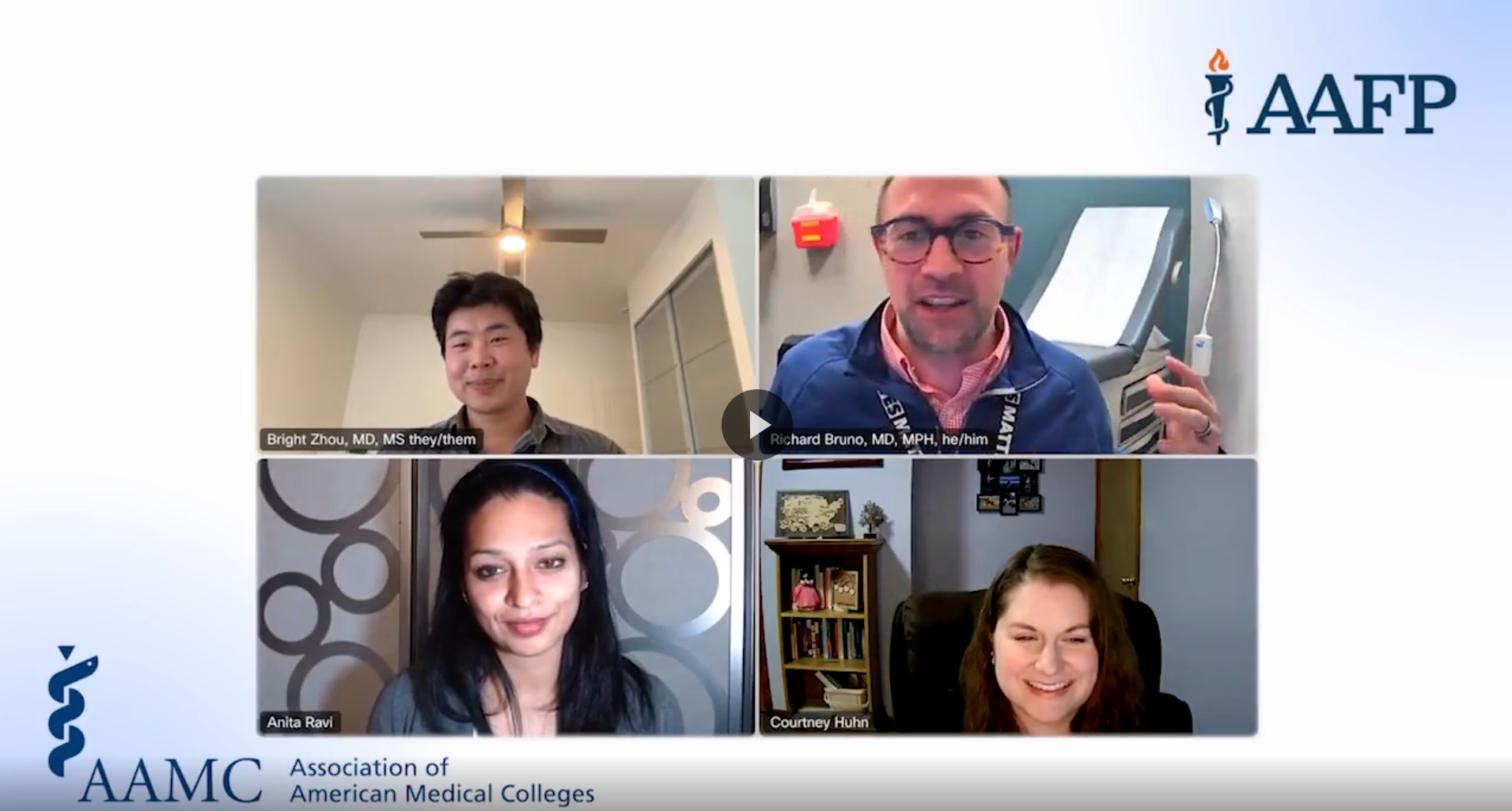Career Options in Family Medicine

For students who prioritize long-term flexibility regarding where they live and how they work, family medicine is an ideal career choice with major advantages.
Family physicians have broad-scope medical training that allows them to flex a variety of skills in a variety of practice settings. Additionally, because they care for everyone—regardless of age, sex, or gender—family physicians can build a career in nearly any community they wish, no matter the size because they are always in demand.
Family medicine also accommodates those who have special areas of interest, like sports medicine, maternity care, emergency medicine, and more. After residency, family doctors have the option to pursue fellowship training that allows them to further pursue their passions. Keep reading to see a sample of the practice options and areas of focus you can choose from as a family doctor. The AAFP also offers students many opportunities to see the specialty up close. Join for free to get access to special interest groups, conferences, and more.
"Vibe Check: Is Family Medicine Right for Me?" Webinar Series
These one-hour webinars, in partnership with AAMC, are focused on helping you choose a meaningful career that matches your values and interests. Hear from a dynamic panel of family medicine physicians showcasing diverse career paths and offering inspiration and advice for future physicians.
Family physicians are experts in comprehensive care, including acute, chronic, and preventive care. Over time, they build strong relationships with their patients and a deep understanding of the communities they serve. There are many opportunities for doctors interested in delivering this type of patient-centered care. Common themes across practice models are having team-based approach, integrating mental health care, and prioritizing easy access to care for patients.
Direct Primary Care
Employed Status
Multispecialty Group Practice
Part-Time Practice
Private Practice
Rural Practice![]()
Direct Primary Care
A growing percentage of family physicians are choosing to work in direct primary care (DPC), a practice and payment model in which patients pay their physician directly―usually a flat monthly or annual fee―for a defined set of primary care services. Under a DPC contract, patients may also receive real-time access to their family physician via advanced communication technology; extended or even home-based visits; and highly personalized, coordinated, and comprehensive care administration. Because not all health care services are covered by the DPC retainer, patients are often encouraged to carry insurance to cover services that can’t be provided in the primary care setting, such as subspecialty care and hospitalizations.
By removing third-party insurance from the patient-physician relationship, DPC puts physicians and patients firmly in control of decisions about routine primary care. Plus, the DPC model can stabilize a practice’s finances, allowing the physician and staff to focus on the patient’s care needs and outcomes and not on coding and billing.
Employed Status
A growing percentage of physicians elect to be employees of a hospital, community health center, or multispecialty group practice. Not having to pay overhead costs or deal with staffing and administrative issues is appealing to many. It is important to talk with physicians in each setting to better understand the pros and cons of these practice arrangements.
Multispecialty Group Practice
Practices may include specialists from family medicine and other primary care specialties, orthopedics, and cardiology in one building to enhance patient access. One of the advantages of working in a multispecialty group practice is that multiple patient services are provided at one location, enabling better communication and convenience for patients.
Part-Time Practice
Family physicians may choose to practice medicine part-time in order to take care of their families, pursue other interests or prepare for retirement. Part-time practice is economically viable for many family physicians, but can be financially challenging for others. Another alternative to full-time practice is job sharing, one full-time equivalent (FTE) position shared by two physicians who each work part-time. This option is advantageous because it frequently cuts down on paperwork and administrative duties.
Private Practice: Solo Owner or Group
Family physicians enjoy the career flexibility between running their own practices and working with colleagues in a group setting.
Rural Practice
The geographic spread of family physicians across the country more closely matches the geographic spread of the general population than any other medical specialty. In treating underserved populations, physicians in rural areas encounter illiteracy, poverty, and limited community resources.
The National Rural Recruitment and Retention Network matches health care professionals with jobs in rural and underserved areas helps to locate practice sites in rural and underserved areas.
Select Special Areas of Focus in Family Medicine
The broad scope in family medicine training prepares physicians to practice in a wide variety of situations. As a family physician, you're free to practice your passion, where and how it fits your career and lifestyle goals.
Education
Emergency and Urgent Care
Hospitalist/Inpatient Medicine
International and Wilderness Medicine
Maternity Care
Public Health
Procedures
Research
Sports Medicine
Education
By joining the medical school faculty as a professor, clerkship director or even dean, family physicians can incorporate teaching and working with medical students into their careers. Serving as a community preceptor, an attending for a clinical rotation or joining a residency program as a faculty member are additional ways that family physicians participate as educators.
Emergency and Urgent Care
Family physicians who have hospital privileges sometimes choose to work exclusively in emergency departments or urgent care centers.
Family physicians often provide the majority of emergency care in rural areas that do not have a designated emergency care doctor.
Hospitalist/Inpatient Medicine
Family physicians possess unique attitudes, skills, and knowledge which qualify them to provide continuing and comprehensive medical care to each hospital patient regardless of sex, age or medical problem. They regularly act as the hub of medical care in the hospital, coordinating care and advice between other specialists.
Family physicians can choose to be dedicated inpatient physicians, or hospitalists, on a full-time or rotating basis, depending on the demand and level of inpatient care needed. Family physicians with hospital privileges can offer continuous care to their patients during hospital stays.
International and Wilderness Medicine
Because family physicians care for all people—regardless of sex, age or disease state—they are uniquely prepared to address a myriad of health issues under a broad range of circumstances, including in areas where resources are scarce or in extreme conditions such as those following a natural disaster. Family medicine’s emphasis on community and public health also enables family physicians to do a community assessment in addressing needs.
Maternity Care
All family physicians are trained in obstetrics, and some offer a full scope of maternity care services, encompassing pre- and post-natal care as well as deliveries (including caesarean). In underserved or rural areas, the provision of maternity care may be an essential service that family physicians provide.
Public Health
Many physicians choose to join the National Health Service Corps, which places primary care physicians in medically underserved (often rural) areas, or the Indian Health Service, where physicians currently provide health services to approximately 1.5 million American Indians and Alaska Natives who belong to more than 557 federally recognized tribes in 35 states. Some family physicians consult on grant projects, lead working groups or guide task forces to look at disease epidemiology, health promotion, and disparities research. Other family physicians pursue additional training in public health (a Master’s degree or PhD) to become medical directors in county or state health departments.
Procedures
Family physicians are trained to perform a number of office procedures, including: maternity-related procedures, procedures related to family planning and early pregnancy evaluation and management, colonoscopies, endoscopies, IUD placement, colposcopies, skin biopsies, suturing lacerations, vasectomies, and more.
Research
Research is an important component of family medicine. Some family physicians collect data about the patients and communities they serve, exploring specific clinical problems or the way in which primary care is organized and delivered. Others may seek opportunities to do research on a full-time basis, as primary investigators of federally funded projects and/or in research positions in academic settings.
Sports Medicine
A growing interest in sports medicine has led some family physicians to take on the role of team physician for various sports from local high schools to the college and professional levels. Family physicians are well suited to this area because of their ability to treat orthopedic as well as general medical problems. The AAFP encourages family physicians to serve as sports medicine doctors in their communities, and many family medicine residencies sponsor sports medicine fellowships as well.

